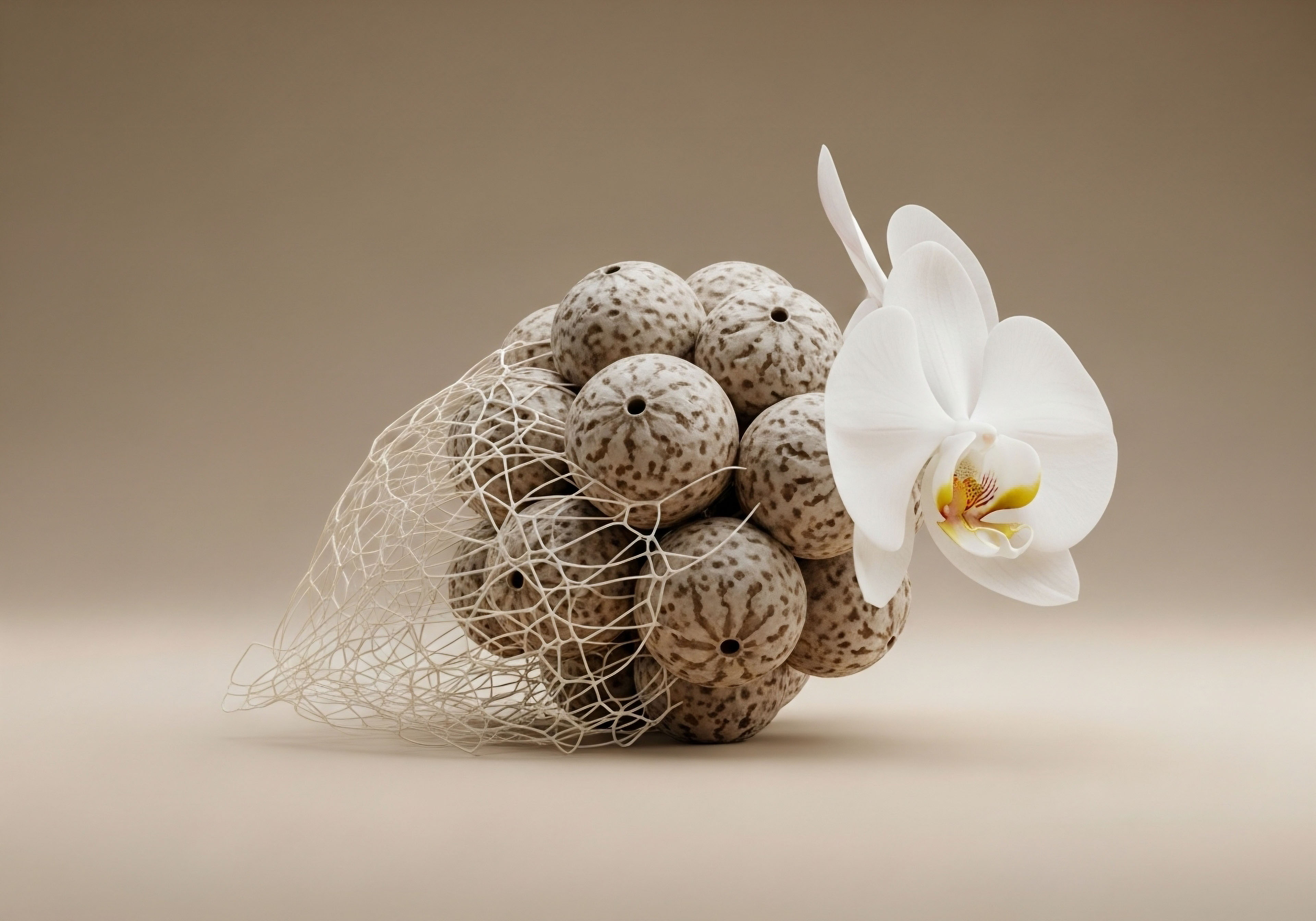

Fundamentals
You may have noticed a subtle shift in your cognitive world. The name that was just on the tip of your tongue vanishes. The thread of a complex idea unravels just as you were about to grasp it.
This experience, often dismissed as a simple consequence of aging or stress, is a deeply personal and valid observation of a profound biological transition. Your brain is a responsive, living system, and its function is intricately linked to the chemical messengers that orchestrate your body’s daily operations.
The question of whether hormonal optimization can sharpen the mind as we age invites us to look at the very chemistry of cognition. It is an inquiry into the possibility of reclaiming a sense of mental acuity and resilience that feels diminished.
This journey begins with understanding that key hormones are also powerful neurosteroids, meaning they are synthesized within the brain and exert significant influence over its structure and function. The brain is not merely a passive recipient of these signals; it is an active participant, rich with receptors for these molecules.
When we speak of estrogen, testosterone, and progesterone, we are discussing foundational components of neural architecture and communication. Their presence or absence shapes your cognitive landscape, influencing everything from memory formation to mood regulation and mental processing speed. The changes you feel are real because the underlying biological shifts are real.

The Brains Internal Architects
Thinking of these hormones solely in reproductive terms is like viewing a master architect as only a plumber. Their roles are far more expansive and foundational to your neurological well-being. They are the directors of your brain’s cellular maintenance, defense, and communication systems.

Estrogen the Master Protector
Estrogen, particularly estradiol, is a primary guardian of neuronal health. It supports the growth and survival of neurons, the fundamental cells of the nervous system. It also enhances the formation of synapses, the connections between neurons that allow for learning and memory.
Estrogen acts as a potent antioxidant within the brain, defending delicate neural tissues from oxidative stress, a form of cellular damage that accumulates over time. It also modulates the production and activity of key neurotransmitters, including serotonin and dopamine, which are vital for mood, focus, and motivation. A decline in estrogen can therefore correspond to a perceptible decrease in the brain’s protective shields and communication efficiency.

Testosterone the Engine of Focus
In both men and women, testosterone plays a vital role in cognitive domains such as spatial reasoning, verbal memory, and executive function. It fuels mental energy and assertiveness, contributing to a sense of focus and drive. Think of it as a modulator of the brain’s processing power, helping to maintain the integrity of the neural pathways that support rapid and clear thought.
Observational studies have consistently linked lower testosterone levels in aging men with a higher incidence of cognitive impairment, suggesting its presence is a key factor in maintaining long-term cognitive structure. Its influence is about the force and clarity of cognitive output.

Progesterone the Calming Agent
Progesterone’s influence on the brain is deeply connected to its role as a precursor to allopregnanolone, a powerful neurosteroid that promotes a sense of calm and well-being. Allopregnanolone interacts with GABA receptors, the primary inhibitory system in the brain. This action helps to quiet neural “noise,” reducing anxiety and promoting restorative sleep.
Since high-quality sleep is essential for memory consolidation and cognitive cleanup, progesterone’s role is profoundly important for next-day mental performance. The fluctuations and eventual decline of progesterone during perimenopause and menopause can contribute to feelings of anxiety, irritability, and sleep disturbances, all of which have a direct, negative impact on cognitive function.
The subjective feeling of cognitive change during midlife directly reflects tangible shifts in the brain’s hormonal environment.

Why Does Cognition Change during Life Transitions?
The life stages of perimenopause, menopause, and andropause represent significant shifts in the body’s endocrine system. These are not sudden events but gradual processes where the production of estrogen, progesterone, and testosterone wanes. As the levels of these critical neurosteroids decline, the brain’s internal support systems are altered.
The cellular protection, synaptic plasticity, and neurotransmitter balance that these hormones once maintained begin to function differently. The “brain fog,” memory lapses, and difficulty concentrating that many people report are the experiential consequence of this biological recalibration. Your brain is adapting to a new internal environment, one with less of the chemical support it was accustomed to for decades.
Understanding this connection is the first step toward addressing it, viewing these cognitive symptoms as signals from a system in transition, rather than an inevitable and irreversible decline.


Intermediate
To appreciate the connection between hormonal balance and cognitive longevity, we must examine the specific biological mechanisms through which these molecules operate within the central nervous system. The cognitive symptoms experienced during hormonal decline are the surface-level expression of deep cellular and molecular changes.
Hormones like estrogen and testosterone are not just passive substances; they are active signaling keys that unlock specific genetic programs and biochemical cascades within neurons, influencing their ability to survive, communicate, and adapt. This section explores the precise ways these hormonal signals translate into the cognitive functions we experience daily, moving from the what to the how.
The conversation around hormonal optimization for cognitive health is dominated by a central concept known as the “critical window” hypothesis. This theory proposes that the brain’s receptivity to the neuroprotective benefits of hormone therapy is time-sensitive. Imagine the brain’s hormonal receptors as a communication system that has been active for decades.
When the hormonal signals fade during menopause or andropause, these receptors remain active and listening for a period. If hormonal support is initiated during this window, the system can be effectively restored. Clinical research, particularly the contrast between the Women’s Health Initiative Memory Study (WHIMS) and the Kronos Early Estrogen Prevention Study (KEEPS), provides evidence for this concept.
The WHIMS, which administered hormones to women much later in life (65 and older), found an increased risk of cognitive decline. The KEEPS, which initiated therapy in women close to the onset of menopause, found no cognitive harm and some benefits in mood. This suggests timing is a determinant of the outcome.

The Neuroprotective Mechanisms of Sex Steroids
The brain’s resilience is dependent on a set of protective mechanisms that shield neurons from damage and stress. Estrogen and testosterone are key regulators of these defenses, and their decline leaves the brain more vulnerable to age-related insults.

Estrogen’s Cellular Defense Program
Estrogen’s role as a neuroprotectant is multifaceted and operates through several distinct pathways. Its actions are mediated by specific estrogen receptors (ERα and ERβ) found throughout the brain, particularly in areas crucial for memory like the hippocampus.
- Anti-Apoptotic Signaling ∞ Estrogen actively suppresses programmed cell death, or apoptosis. It achieves this by increasing the expression of the anti-apoptotic gene Bcl-2. Think of Bcl-2 as a bodyguard for the neuron, preventing the activation of the cell’s self-destruct sequence in response to stress or injury.
- Activation of Survival Pathways ∞ Through non-genomic actions, estrogen can rapidly activate intracellular signaling cascades like the PI3K/Akt and ERK pathways. These pathways are fundamental “pro-survival” signals that promote cell growth, proliferation, and resilience against a wide range of toxic insults.
- Mitochondrial Support ∞ Estrogen supports the function of mitochondria, the powerhouses of the cell. Healthy mitochondria are essential for meeting the brain’s high energy demands. By optimizing mitochondrial function, estrogen helps maintain the energy supply needed for complex cognitive tasks.
- Reducing Neuroinflammation ∞ Chronic inflammation is a key driver of neurodegenerative processes. Estrogen exerts anti-inflammatory effects by modulating the activity of microglia, the brain’s resident immune cells. It helps keep these cells in a protective, “housekeeping” state, preventing them from becoming overactive and causing inflammatory damage.

Testosterone and Brain Architecture
Testosterone and its potent metabolite, dihydrotestosterone (DHT), also exert significant neuroprotective effects. The association between low testosterone in men and an increased risk for Alzheimer’s disease points to its importance in long-term brain health. The inconsistency in clinical trials of testosterone supplementation improving cognition suggests a complex relationship.
The benefits may be more about prevention and maintaining existing structures than reversing established deficits. Testosterone helps maintain the volume of grey matter in key brain regions and supports myelination, the process that insulates nerve fibers and allows for efficient electrical signaling. Its decline can be seen as a slow erosion of the brain’s physical infrastructure.
The “critical window” hypothesis suggests that the timing of hormonal intervention is a key determinant of its cognitive impact.

Clinical Protocols for Hormonal and Peptide Optimization
Modern clinical practice approaches hormonal health with precise, personalized protocols. The goal is to restore physiological balance using bioidentical hormones and targeted peptides that support the body’s own signaling systems. These interventions are designed to address the root causes of symptoms, including cognitive changes, by recalibrating the underlying endocrine environment.

Hormonal Optimization Protocols
The following table outlines standard therapeutic approaches for men and women, designed to restore hormonal levels to a range associated with vitality and optimal function. The inclusion of ancillary medications is critical for managing potential side effects and ensuring a balanced physiological response.
| Protocol | Target Audience | Primary Agents | Ancillary Components & Rationale |
|---|---|---|---|
| Male TRT | Men with symptoms of andropause/low testosterone. | Testosterone Cypionate (intramuscular or subcutaneous injections). |
Gonadorelin ∞ A GnRH analog used to stimulate the pituitary, maintaining testicular function and natural testosterone production. Anastrozole ∞ An aromatase inhibitor that blocks the conversion of testosterone to estrogen, preventing side effects like gynecomastia and water retention. Enclomiphene ∞ Sometimes used to directly stimulate LH and FSH production from the pituitary, supporting endogenous hormone function. |
| Female HRT | Peri- and post-menopausal women with associated symptoms. | Testosterone Cypionate (low-dose subcutaneous injections); Progesterone (oral or topical); Estradiol (topical or transdermal). |
Progesterone ∞ Used cyclically or continuously to balance estrogen’s effects on the uterus and to provide its own benefits for sleep and mood. Anastrozole ∞ May be used in specific cases, such as with testosterone pellet therapy, to manage estrogen levels if they become elevated. |

Growth Hormone Peptide Therapy
Peptide therapies represent a more nuanced approach, using specific signaling molecules to encourage the body’s own production of growth hormone (GH). This avoids the introduction of synthetic HGH and instead supports the natural function of the pituitary gland. Improved GH levels are associated with better sleep quality, metabolic health, and cellular repair, all of which indirectly and directly support cognitive function.
| Peptide Combination | Mechanism of Action | Targeted Cognitive & Wellness Benefits |
|---|---|---|
| Ipamorelin / CJC-1295 | Ipamorelin is a GHRP that stimulates a strong, clean pulse of GH. CJC-1295 is a GHRH analog that increases the baseline level of growth hormone. Together, they create a powerful synergistic effect on GH release. |
Improved deep sleep quality, which is critical for memory consolidation. Enhanced mental clarity and reduced “brain fog.” Supports cellular repair processes, including in the brain. |
| Sermorelin | A GHRH analog that stimulates the pituitary gland to produce and secrete more of the body’s own growth hormone. It mimics the body’s natural processes. |
Promotes restorative sleep cycles. Increases energy levels and metabolic function. Supports overall vitality, which contributes to better cognitive endurance. |
| Tesamorelin | A potent GHRH analog specifically studied for its effects on metabolic health, particularly reducing visceral adipose tissue, which is linked to inflammation. |
Improves metabolic markers, reducing a key risk factor for cognitive decline. Some studies suggest direct cognitive benefits, particularly in specific populations. |


Academic
A sophisticated analysis of hormonal influence on cognition requires a departure from a single-molecule, single-effect model. The brain does not function in a vacuum; it is the command center of an integrated biological system. Therefore, the cognitive consequences of hormonal decline are best understood through the lens of systems biology.
The question of cognitive enhancement via hormonal therapy becomes an inquiry into systemic recalibration. The central thesis is that the neuroprotective and cognitive benefits of hormonal optimization are emergent properties of restoring balance across multiple interconnected physiological axes, primarily the neuro-endocrine-immune and metabolic systems. This perspective reframes the debate from simple “replacement” to a more complex “systemic modulation.”
The primary driver of age-related sex hormone decline is the progressive dysregulation of the Hypothalamic-Pituitary-Gonadal (HPG) axis. This intricate feedback loop, which governs the release of gonadotropin-releasing hormone (GnRH) from the hypothalamus, luteinizing hormone (LH) and follicle-stimulating hormone (FSH) from the pituitary, and steroid hormones from the gonads, loses its precision with age.
In men, testicular sensitivity to LH decreases. In women, ovarian follicular depletion leads to a cessation of estrogen and progesterone production, causing a surge in GnRH and gonadotropins. This axis disruption is the upstream event that precipitates the downstream consequences for brain health. The cognitive effects are therefore a direct result of the loss of homeostatic control within this master regulatory axis.

What Is the Interplay of Hormones Metabolism and Neuroinflammation?
The brain is an organ with immense metabolic demands, consuming approximately 20% of the body’s oxygen and glucose at rest. Its cognitive function is exquisitely sensitive to bioenergetic efficiency. The decline in sex steroids is closely intertwined with a decline in metabolic health, creating a vicious cycle that accelerates cognitive aging.

The Convergence of Hormonal Decline and Insulin Resistance
Estrogen and testosterone are potent modulators of insulin sensitivity. Estrogen helps regulate glucose transport in the brain and promotes healthy lipid profiles. Testosterone is critical for maintaining lean muscle mass, which is the body’s primary site of glucose disposal. As these hormones decline, the body’s ability to manage glucose is impaired, often leading to systemic insulin resistance.
This condition is particularly detrimental to the brain. Impaired insulin signaling in the hippocampus disrupts synaptic plasticity and memory formation. The link between insulin resistance and Alzheimer’s disease is so strong that some researchers have termed AD “Type 3 diabetes.” Hormonal optimization protocols that restore testosterone and estrogen levels can improve insulin sensitivity, thereby providing a powerful, indirect mechanism for supporting brain bioenergetics and cognitive function.

Inflammaging a Unifying Concept
Aging is characterized by a state of chronic, low-grade, sterile inflammation, a phenomenon termed “inflammaging.” This systemic inflammation is a significant contributor to neuroinflammation, which drives neuronal damage in nearly all neurodegenerative conditions. Sex steroids, particularly estrogen, possess potent anti-inflammatory properties.
They help to suppress the production of pro-inflammatory cytokines and modulate the activation state of microglia, the brain’s immune sentinels. The loss of these hormones removes a critical anti-inflammatory brake, allowing the inflammaging process to accelerate within the central nervous system. Therapeutic interventions that restore these hormonal signals help to re-establish this brake, mitigating the neurotoxic effects of chronic inflammation and preserving a healthier neural environment.
Viewing cognitive enhancement through a systems biology lens reveals that its benefits arise from restoring balance across neuro-endocrine, metabolic, and immune networks.

Reconciling the Clinical Evidence a Deeper Analysis
The apparent conflict in the clinical literature regarding HRT and cognition is less a contradiction and more a reflection of the complexity of the system being studied. A systems-level perspective helps to reconcile these findings.
- Observational Studies vs. Randomized Controlled Trials (RCTs) ∞ Observational studies, which often show a cognitive benefit to HRT, may be subject to “healthy user bias”; women who choose to take HRT may also engage in other healthy lifestyle behaviors that protect cognition. RCTs, while the gold standard, often test a single formulation in a specific population for a limited duration. The Women’s Health Initiative (WHI) used oral conjugated equine estrogens and a synthetic progestin (medroxyprogesterone acetate), which have different metabolic and inflammatory profiles than bioidentical estradiol and progesterone. The null or negative findings of some RCTs may reflect the specific intervention used, the timing of initiation, or the specific population studied, rather than a universal truth about all forms of hormonal therapy.
- Cognitive Domains and Measurement ∞ Cognition is not a monolithic entity. It comprises multiple domains ∞ verbal memory, executive function, processing speed, and spatial ability. A therapeutic intervention may affect one domain without significantly altering another. Many trials use global cognitive scores that can miss subtle, domain-specific improvements. Future research requires more granular neuropsychological testing to fully characterize the cognitive effects of hormonal optimization. For example, while testosterone supplementation has shown inconsistent effects on global cognition, some studies do report improvements in specific areas like verbal memory or motor speed.

How Do Peptides Fit into the Systems Biology Model?
Peptide therapies, particularly those that stimulate the GH/IGF-1 axis, add another layer of systemic modulation. Growth hormone is not just for growth; it is a master metabolic regulator. By stimulating GH release with peptides like Ipamorelin or Tesamorelin, clinicians can influence several pathways that support brain health.
Improved sleep architecture, particularly an increase in deep-wave sleep, is one of the most consistently reported benefits of GH secretagogues. During deep sleep, the brain engages in critical maintenance activities, including the clearance of metabolic waste products like amyloid-beta via the glymphatic system.
By enhancing sleep quality, these peptides directly support the brain’s nightly cleanup crew, a fundamental process for long-term cognitive health. Furthermore, the downstream effects of GH, mediated by IGF-1, include promoting neurogenesis and synaptic plasticity, providing direct support for the brain’s ability to learn and adapt. These peptides work in concert with sex hormone optimization to create a more robust and resilient internal environment conducive to sustained cognitive function.

References
- Brann, Darrell W. et al. “Neurotrophic and neuroprotective actions of estrogen ∞ basic mechanisms and clinical implications.” Endocrinology, vol. 148, no. 7, 2007, pp. 3070-3079.
- Janicki, Joseph S. and Karl T. Weber. “Testosterone supplementation and cognitive functioning in men ∞ A systematic review and meta-analysis.” The Journal of Clinical Endocrinology & Metabolism, vol. 104, no. 8, 2019, pp. 3435-3449.
- Resnick, Susan M. et al. “Long-term cognitive effects of menopausal hormone therapy ∞ Findings from the KEEPS Continuation Study.” PLoS Medicine, vol. 20, no. 11, 2023, e1004301.
- Gleason, Carey E. et al. “Effects of hormone therapy on cognition and mood in newly postmenopausal women ∞ findings from the KEEPS-cognitive and affective study.” PLoS Medicine, vol. 12, no. 6, 2015, e1001833.
- Savolainen-Peltonen, Hanna, et al. “Use of hormone replacement therapy and risk of Alzheimer’s disease ∞ a nationwide nested case-control study.” BMJ, vol. 364, 2019, l665.
- Islam, Md. Shafiul, et al. “Testosterone and cognitive impairment or dementia in middle-aged or aging males ∞ causation and intervention, a systematic review and meta-analysis.” Journal of Alzheimer’s Disease, vol. 76, no. 1, 2020, pp. 299-315.
- Freeman, Ellen W. and Mary D. Sammel. “Progesterone and human cognition.” Climacteric, vol. 19, no. 3, 2016, pp. 240-246.
- Dubal, Dena B. and Christian J. Pike. “Minireview ∞ Neuroprotective effects of estrogen ∞ new insights into mechanisms of action.” Endocrinology, vol. 143, no. 12, 2002, pp. 4535-4538.
- Middleton, L. S. et al. “Growth hormone improves cognitive function after experimental stroke.” Stroke, vol. 49, no. 5, 2018, pp. 1236-1244.
- Dong, Xiaoyu, et al. “Low serum testosterone concentrations are associated with poor cognitive performance in older men but not women.” Frontiers in Aging Neuroscience, vol. 13, 2021, p. 712237.

Reflection
You have now journeyed through the intricate biological landscape that connects your hormonal systems to your cognitive vitality. This knowledge provides a map, illustrating the pathways and mechanisms that shape your mental world. It translates the subjective experience of “brain fog” into the objective language of cellular biology, validating that what you feel is grounded in physiological reality. This understanding is the essential first step.
The next step is one of personal inquiry. With this map in hand, consider your own unique terrain. Where do you observe the interplay between your energy levels, your sleep quality, your mood, and the sharpness of your thoughts? Recognizing these personal connections moves this knowledge from the abstract to the actionable. The science provides the “why,” but your lived experience provides the “where” and “when.”
This exploration reveals that maintaining cognitive function is an active process of biological stewardship. It is about tending to the complex, interconnected systems that support a thriving mind. The information presented here is a powerful tool for dialogue, a foundation upon which you can build a proactive partnership with a clinician who understands this systemic approach. Your personal health narrative, informed by this clinical science, becomes the most important dataset in crafting a path toward sustained cognitive vitality.


